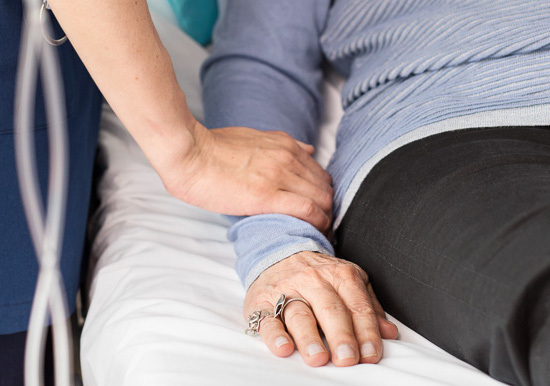Breast reconstruction surgery means meticulous craftsmanship by experienced surgeons
Reconstructing a removed breast is part of the treatment path of many breast cancer patients. The goal of the surgery...
Read moreMon–Thu 8–18, Fri 8–16

HDR is an effective form of intra-tissue radiotherapy in which the radiation dose within the prostate can be increased very high without significant side effects for the patient. Docrates Cancer Hospital is Finland's most experienced provider of HDR brachytherapy.
There are two types of brachytherapy: LDR (low dose rate) and HDR (high dose rate) internal radiotherapy. Finnish operators are discontinuing LDR brachytherapy to replace it with high dose rate brachytherapy or HDR brachytherapy, which uses a highly active iridium isotope (Ir-192) as a radiation source.
HDR brachytherapy offers significant benefits compared with the LDR brachytherapy previously used at Docrates Cancer Center, too. Unlike LDR brachytherapy (Low Dose Rate), HDR brachytherapy can be used to treat prostate cancer that has spread beyond the prostatic capsule. In HDR brachytherapy, the momentary dose of radiation is computationally up to tens of thousands of times larger than the dose given in LDR brachytherapy, meaning that it kills cancer cells more effectively.
HDR (High Dose Rate) brachytherapy is primarily used to enhance external prostate cancer radiotherapy, but it is also used as the monotherapy for prostate cancer.
HDR brachytherapy can be used as monotherapy for local low-risk prostate cancers. When it comes to medium-high-risk and high-risk cancers as well as locally advanced prostate cancers, the combination of external radiotherapy and HDR therapy appears to be particularly effective, while the recurrence of cancer in the prostate gland is considerably less likely and the probable appearance of metastases is smaller compared with mere external radiotherapy or surgery.
Even though the radiation dose level in HDR brachytherapy is very high, the external healthy tissues, such as the bladder or the rectum, will be spared from adversely high doses of radiation, as it is possible to deliver the high radiation dose directly to the prostate area only. Consequently, it is possible to minimise the adverse effects. This also explains why there is hardly any reason for active follow-up for low-risk prostate cancer.
High dose rate (HDR) brachytherapy is also used as a salvage therapy after prior external radiotherapy in the event of recurrence of the disease, because in HDR therapy the doses on healthy tissue can be kept at a low level. Salvage radiotherapy is a novel approach: previously, re-exposing an area to radiation was not considered rational and few related studies were published. However, publications related to salvage HDR brachytherapy have considerably increased in number and initial results are very promising.
HDR brachytherapy may also be combined with other treatments for metastatic prostate cancer.
Fears associated with prostate cancer treatments often concern the maintenance of quality of life such as erectile dysfunction and urinary incontinence, and in particular the ability to hold urine. In HDR brachytherapy, the high dose of radiation can only be limited to the prostate area. Precision radiotherapy thus protects healthy tissues, resulting in a better quality of life in terms of sexual function and urinary retention than surgery or external radiotherapy. The effect of the male hormone on prostate cancer cells is reduced during radiotherapy with hormone therapy because it is known to improve the effectiveness of radiotherapy, especially in the most aggressive stages of prostate cancer. However, hormone therapy is short-lived and is stopped six months to two years after the end of radiotherapy. In most cases, erection problems are relieved afterwards, and sex life is restored with erection medication.
HDR brachytherapy is performed by a team including a urologist and a medical physicist well versed in radiotherapy technology and dose calculation. The team also includes an anaesthetist, a specialist oncologist, an assisting radiographer and an assisting nurse.
HDR brachytherapy is a method whereby 10–20 needles are inserted through the perineum and the prostate gland below the bladder. In a way, the prostate is pierced by several needles. The thickness of the needles is 1.5 mm. The procedure is performed under general anesthesia or spinal anesthesia. The doctor draws the boundaries of the prostate gland at the dose planning station and determines the location of the urethra. The medical physicist then prepares the preliminary dose plan and determines the number and locations of the needles. Radiotherapy targets the entire prostate gland. However, dose planning takes into account any areas of prostate cancer verified though biopsies and imaging, and the team will try to maximise the radiation delivered to these areas.
The needles will then be placed in their allocated locations using external coordinates. The insertion of the needles changes the state of the prostate gland somewhat. This will be observed by correcting the changes in the boundaries of the prostate and the urethra, as induced by the transition. Other healthy tissue that is sensitive to the radiation will be added to the drawing at this point at the latest, including the rectum and the bladder. The medical physicist will then prepare the final dose plan, which observes the actual location of the needles.
When the dose plan has been completed, the line wires of the afterloading therapy device are connected to each needle. The iridium-192 radiation source will enter the needles through the wires and remain in each needle for a period of time in accordance with the dose plan, moving at 2.5 mm intervals under remote control. The longer the radiation source stays in one place, the higher the local radiation dose. The radiation session lasts 10–20 minutes. Once the session has been completed, the needles are removed and the bladder catheter is opened, and the patient is wakened and transferred to a ward for observation. The patient will stay the night in the ward. A total of 2-3 treatments are typically needed.
International reports published in medical publications illustrate the effectiveness of the HDR technique in low-, medium- and high -risk patient groups. The renowned German HDR centre and radiotherapy clinic Offenbach has published a report covering the treatment of 718 patients. After HDR monotherapy, 95% of the patients were free from disease after 5 years of monitoring.
A Dutch report published in 2011 showed that 97% of the 264 low- and medium-high-risk group patients were free from disease 7 years after treatment. The renowned New York based Memorial Sloan Kettering Cancer Center gave 199 high risk patients out of a total of 229 patients an extremely high dose of 199 Gy. A total of 81% of the patients were free from disease 7 years later.
The combination of external radiotherapy and HDR therapy appears to be particularly effective in high-risk patient groups compared with using external radiotherapy as monotherapy. The adverse effects of the combination therapy are no more common or serious than those of external radiotherapy as monotherapy.
At Docrates Cancer Center, M.D. Lauri Taipale, specialist in surgery and urology, and Andrei Dejev, specialist in urology, are in charge of HDR brachytherapy. Docrates was the first to start HDR brachytherapy in Finland in 2009. With more than a 1600 HDR brachytherapy treatments Docrates is the most experienced provider of HDR brachytherapy as a form of prostate cancer radiotherapy in Finland.
According to our experience, the side effects of both external and internal radiation therapy of prostate cancer are considerably milder than those of prostatectomy. The reason for this is the fact that in modern radiotherapy, high doses of radiation can be directed at the cancer area only, sparing the healthy tissues from high doses of radiation.
As it is possible to target the radiation dose to the tumor precisely, for example urinary incontinence and impotence occur less frequently than after surgery.
Literature:
Kishan et al. (2018) Radical Prostatectomy, External Beam Radiotherapy, or External Beam Radiotherapy With Brachytherapy Boost and Disease Progression and Mortality in Patients With Gleason Score 9-10 Prostate Cancer, Jama, 319 (9), 896-905.
Hamdy et al. (2016) 10-year Outcomes After Monitoring, Surgery or Radiotherapy for Localized Prostate Cancer, The New England Journal of Medicine, September 14, 2016, 1-10.
Reconstructing a removed breast is part of the treatment path of many breast cancer patients. The goal of the surgery...
Read more
New forms of treatment based on molecular diagnostics enable more and more patients to completely recover from cancer, and make...

With a transaction signed on 2 September 2024, Mehiläinen has acquired Docrates Ltd, as a result of which Docrates Cancer...

On 27, August 2024, the Finnish Competition and Consumer Authority (FCCA) approved the merger of Mehiläinen and Docrates Cancer Center....
Contact us!
Mon-Thu 8:00-18:00, Fri 8:00-16:00
